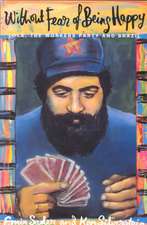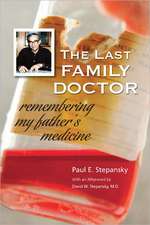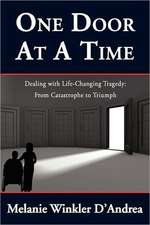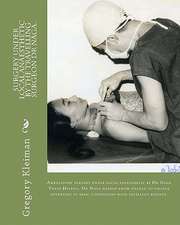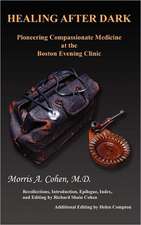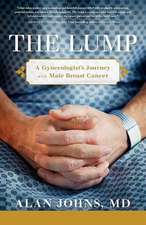The Radioactive Boy Scout: The Frightening True Story of a Whiz Kid and His Homemade Nuclear Reactor
Autor Ken Silversteinen Limba Engleză Paperback – 31 dec 2004 – vârsta de la 14 până la 18 ani
Vezi toate premiile Carte premiată
Posing as a physics professor, David solicited information on reactor design from the U.S. government and from industry experts. Following blueprints he found in an outdated physics textbook, David cobbled together a crude device that threw off toxic levels of radiation. His wholly unsupervised project finally sparked an environmental emergency that put his town’s forty thousand suburbanites at risk. The EPA ended up burying his lab at a radioactive dumpsite in Utah. This offbeat account of ambition and, ultimately, hubris has the narrative energy of a first-rate thriller.
Preț: 114.47 lei
Nou
Puncte Express: 172
Preț estimativ în valută:
21.90€ • 22.93$ • 18.23£
21.90€ • 22.93$ • 18.23£
Carte disponibilă
Livrare economică 10-24 martie
Preluare comenzi: 021 569.72.76
Specificații
ISBN-13: 9780812966602
ISBN-10: 0812966600
Pagini: 240
Dimensiuni: 144 x 199 x 14 mm
Greutate: 0.18 kg
Editura: Villard Books
Locul publicării:New York, NY
ISBN-10: 0812966600
Pagini: 240
Dimensiuni: 144 x 199 x 14 mm
Greutate: 0.18 kg
Editura: Villard Books
Locul publicării:New York, NY
Notă biografică
KEN SILVERSTEIN is an investigative reporter for the Washington, D.C., bureau of the Los Angeles Times. A former contributing editor to Harper’s Magazine, in which a portion of this story first appeared, he has written for Mother Jones, The Nation, and The American Prospect, among others. He lives in Washington, D.C.
From the Hardcover edition.
From the Hardcover edition.
Extras
Chapter 1
Roots: The Making of a Teenage Scientist
You—Scientist!
—The Golden Book of Chemistry Experiments, 1960
David Hahn’s earliest memory seems appropriate in light of later events; it is of conducting an experiment in the bathroom when he was perhaps four years old. With his father at work and his unmindful mother listening to music in the living room of the family’s small apartment in suburban Detroit, he rummaged through the medicine chest and undersink cabinet and gathered toothpaste, soap, medicines, cold cream, nail polish remover, and rubbing alcohol. He mixed everything in a metal bowl and stirred in the contents of an ashtray used by his mother, a chain-smoker. “I was trying to get a magical reaction, to create something new,” he remembered later. “I thought that the more things I threw in, the stronger the reaction I’d get.”
After he finished blending the ingredients together, young David was disappointed to see that all he had in the bowl was a lifeless, grayish glob. Hence, he went back to the cabinet beneath the sink and pulled out a bright-blue bottle, which years later he realized was probably a drain-cleaning product. He uncapped the bottle and poured a healthy amount into the bowl; soon, the mixture began to bubble and threatened to boil over. In a panic, David flushed the contents of the bowl down the toilet. His parents never knew what happened, and David promised himself that he would never again try something so foolish. It was the first of many similar vows made over the years, all broken in short order. It also established a pattern: experiment, trouble, cover-up.
If David was a slightly odd child, his parents, lost in their own preoccupations, hardly noticed. His father, Ken Hahn, grew up in the Detroit area along with his four brothers and sisters. Ken’s father was a skilled tradesman, a tool-and-die maker who worked for General Electric and Pratt & Whitney. At night, Ken would sit with his dad and pore over blueprints of the tools his dad made during his workday. By the time he reached Henry Ford High School, Ken had decided to pursue a similar career, though he was fascinated by the idea of drawing the blueprints, not building the tools. He enrolled in a college-prep program for mechanical engineering and after graduating attended Lawrence Technological University, a local school.
Ken was so wrapped up with his engineering studies that he had little time for dating or romance. But while a sophomore at Lawrence Tech, he and a friend were cruising Woodward Avenue just outside of Detroit when they spotted two pretty girls driving alongside his Chevy Chevelle. After signaling for them to pull into a Big Boy hamburger drive-in, Ken zeroed in on nineteen-year-old Patty Spaulding and came away with her phone number. For Ken, it was love at first sight. “She was cute as a bug,” he remembered later, proudly showing off a picture of a beautiful young woman with a bouncy smile.
But Patty, having recently ended a stormy relationship, was initially aloof. She had not had many positive experiences with men. Patty had been raised in a poor region of West Virginia, and her father had abandoned the family when she was young. Her mother, Lucille, had packed up and moved the family to Detroit, where they had relatives. Lucille found work at a doctor’s office, and the family moved into the middle class, albeit at the lower end of that category. It wasn’t an easy life, but it was better than West Virginia.
Ken was a determined suitor, though. After a four-year courtship during which he displayed the same tenacity that he normally reserved for work-related engineering challenges, Ken finally wore down Patty’s resistance. They were married in July 1974.
Like those of all residents of contemporary Detroit, Ken and Patty’s lives were shaped physically, economically, and socially by the automobile industry. The metropolitan area was then home to Ford, General Motors, and Chrysler, as well as to thousands of small shops that produced machine parts, brake linings, and industrial tools for the Big Three automakers. Soon after the wedding, Ken found a job as a mechanical engineer at a General Motors subcontractor, and he and Patty moved into a suburban apartment complex not far from his office. David, their only child, was born on October 30, 1976.
Ken worked long hours, designing robotic welding machines and other assembly-line equipment. He left home punctually at six in the morning, rarely returning before six in the evening and sometimes not until after David had gone to bed. Tightly wound, Ken was a dutiful husband and father but not a demonstrative one. Combined with his constant air of preoccupation, his reserve must have been confounding to a child. Even when Ken was around the house, there was little interaction between father—David remembered him as “always off in a fog”—and son, who developed an especially close bond with his mother.
In contrast to her husband, Patty was outgoing and affectionate. She loved children and painted watercolors of kids at play, some which were displayed for years at the Detroit Children’s Hospital. Patty lacked Ken’s focus, though, and had a hard time sticking with anything. She’d dropped out of high school three weeks prior to graduation and, despite several attempts, never got around to completing her GED. For a time, she talked about becoming a model and even put together a portfolio before abruptly abandoning the idea.
Patty doted on her son and gave him the attention he couldn’t get from his anxious and distant father. When David wanted a basketball hoop in his room, Patty made Ken put one up. If David liked a song, she’d play it for him over and over again. As David remembered, “My mom might be sleeping in her room when I got home from [elementary] school, but she always popped up to see me, and we’d do my homework together. If I did a drawing at school, she always put it up on the wall and bragged about how great it was to whoever came over, even the plumber. I thought she was the most wonderful person in the world.”
But troubles began to dog Patty, though David was largely unaware of what was happening. She developed the drinking problem that ran in her family. A few years after David was born, she began to hear voices and thought strangers were after her. She was diagnosed with depression and paranoid schizophrenia. A variety of antipsychotic medications were prescribed. Fearing someone was trying to kidnap David, Patty took to changing the locks on the doors. She heard ghosts in the apartment building and would take David by the hand, creep down the basement stairs with a flashlight, and make sure nothing was lurking there. Ken hired a retired woman who lived nearby to check up on Patty and his son when he was at work, but by the time David was four Patty’s condition had deteriorated so badly that she had to be committed to a mental hospital.
To explain her absence, Ken told David that his mother had been hurt when her car skidded off the road during a rainstorm. David suspected the story wasn’t true—it couldn’t have provided much comfort in any case—and felt completely abandoned. Upon hearing that Patty would have to “be away for a while,” he hid behind the couch in the living room, clasped his knees to his chin, and rocked himself back and forth.
Patty returned home six months later, and though she wasn’t hospitalized again after her release her illness lingered and deepened. She rarely worked and spent most of her time at the apartment, caring for David when he wasn’t at school and watching TV, listening to Top 40 hits, and playing cards with her girlfriends when he was. Though Patty still pampered David, she became somewhat less attentive. Left on his own, David developed a wild imagination. He built elaborate sets in his room—caves built from pillows and forts constructed in his closet—on which he could act out games with make-believe space explorers and superheroes. He fantasized endlessly about comic-book hero Spider-Man, the alias of Peter Parker, a dweebish, bespectacled high school student who gained superpowers after being bitten by a radioactive spider.
Meanwhile, the marriage between David’s parents was falling apart, riven by financial troubles and Ken’s frustration with Patty’s failure to look for work or, in his view, deal with her mental troubles. As David peered out from his bedroom, his parents would scream at each other across the living room, and on occasion Patty would hurl a vase or a lamp at the wall. In 1985, when David was nine years old, his parents finally split, and Patty lost custody of her son. It was then that David’s troubles really began.
David stayed with his father, who soon began dating a GM engineer named Kathy Missig. Ken and Kathy—whose daughter from a previous marriage, Kristina, was David’s elder by a year—didn’t marry until six years later, but within a year of meeting they bought a house together in Clinton Township, a conservative working-class area about twenty miles north of downtown Detroit.
Thanks to Detroit’s devotion to the automobile, urban planning and mass transit were, and are, almost unknown to the region. Clinton Township, like other outlying areas, was an endless sprawl of fast-food restaurants, strip malls, shopping centers, and other signposts of suburbia. The Hahns new home was a small but cozy split-level. The family room boasted birch paneling and a fireplace, while David’s bedroom, on the top floor, looked out on a diamond-shaped deck in the backyard, with the requisite affordable luxuries of a barbecue grill, patio furniture, and an aboveground swimming pool.
Ken remained wrapped up with his job and was rarely at home and even more rarely available to his son. He’d often get back long past the dinner hour, so Kathy would leave a plate of food warming for him in the oven. David saw his dad as a hard worker but conservative and living a boring lifestyle. “He talked a lot about work and people I didn’t know anything about,” he said. “He was always telling me that he didn’t spend much money, just a few dollars a day. I wanted my life to be more exciting than that.”
From the Hardcover edition.
Roots: The Making of a Teenage Scientist
You—Scientist!
—The Golden Book of Chemistry Experiments, 1960
David Hahn’s earliest memory seems appropriate in light of later events; it is of conducting an experiment in the bathroom when he was perhaps four years old. With his father at work and his unmindful mother listening to music in the living room of the family’s small apartment in suburban Detroit, he rummaged through the medicine chest and undersink cabinet and gathered toothpaste, soap, medicines, cold cream, nail polish remover, and rubbing alcohol. He mixed everything in a metal bowl and stirred in the contents of an ashtray used by his mother, a chain-smoker. “I was trying to get a magical reaction, to create something new,” he remembered later. “I thought that the more things I threw in, the stronger the reaction I’d get.”
After he finished blending the ingredients together, young David was disappointed to see that all he had in the bowl was a lifeless, grayish glob. Hence, he went back to the cabinet beneath the sink and pulled out a bright-blue bottle, which years later he realized was probably a drain-cleaning product. He uncapped the bottle and poured a healthy amount into the bowl; soon, the mixture began to bubble and threatened to boil over. In a panic, David flushed the contents of the bowl down the toilet. His parents never knew what happened, and David promised himself that he would never again try something so foolish. It was the first of many similar vows made over the years, all broken in short order. It also established a pattern: experiment, trouble, cover-up.
If David was a slightly odd child, his parents, lost in their own preoccupations, hardly noticed. His father, Ken Hahn, grew up in the Detroit area along with his four brothers and sisters. Ken’s father was a skilled tradesman, a tool-and-die maker who worked for General Electric and Pratt & Whitney. At night, Ken would sit with his dad and pore over blueprints of the tools his dad made during his workday. By the time he reached Henry Ford High School, Ken had decided to pursue a similar career, though he was fascinated by the idea of drawing the blueprints, not building the tools. He enrolled in a college-prep program for mechanical engineering and after graduating attended Lawrence Technological University, a local school.
Ken was so wrapped up with his engineering studies that he had little time for dating or romance. But while a sophomore at Lawrence Tech, he and a friend were cruising Woodward Avenue just outside of Detroit when they spotted two pretty girls driving alongside his Chevy Chevelle. After signaling for them to pull into a Big Boy hamburger drive-in, Ken zeroed in on nineteen-year-old Patty Spaulding and came away with her phone number. For Ken, it was love at first sight. “She was cute as a bug,” he remembered later, proudly showing off a picture of a beautiful young woman with a bouncy smile.
But Patty, having recently ended a stormy relationship, was initially aloof. She had not had many positive experiences with men. Patty had been raised in a poor region of West Virginia, and her father had abandoned the family when she was young. Her mother, Lucille, had packed up and moved the family to Detroit, where they had relatives. Lucille found work at a doctor’s office, and the family moved into the middle class, albeit at the lower end of that category. It wasn’t an easy life, but it was better than West Virginia.
Ken was a determined suitor, though. After a four-year courtship during which he displayed the same tenacity that he normally reserved for work-related engineering challenges, Ken finally wore down Patty’s resistance. They were married in July 1974.
Like those of all residents of contemporary Detroit, Ken and Patty’s lives were shaped physically, economically, and socially by the automobile industry. The metropolitan area was then home to Ford, General Motors, and Chrysler, as well as to thousands of small shops that produced machine parts, brake linings, and industrial tools for the Big Three automakers. Soon after the wedding, Ken found a job as a mechanical engineer at a General Motors subcontractor, and he and Patty moved into a suburban apartment complex not far from his office. David, their only child, was born on October 30, 1976.
Ken worked long hours, designing robotic welding machines and other assembly-line equipment. He left home punctually at six in the morning, rarely returning before six in the evening and sometimes not until after David had gone to bed. Tightly wound, Ken was a dutiful husband and father but not a demonstrative one. Combined with his constant air of preoccupation, his reserve must have been confounding to a child. Even when Ken was around the house, there was little interaction between father—David remembered him as “always off in a fog”—and son, who developed an especially close bond with his mother.
In contrast to her husband, Patty was outgoing and affectionate. She loved children and painted watercolors of kids at play, some which were displayed for years at the Detroit Children’s Hospital. Patty lacked Ken’s focus, though, and had a hard time sticking with anything. She’d dropped out of high school three weeks prior to graduation and, despite several attempts, never got around to completing her GED. For a time, she talked about becoming a model and even put together a portfolio before abruptly abandoning the idea.
Patty doted on her son and gave him the attention he couldn’t get from his anxious and distant father. When David wanted a basketball hoop in his room, Patty made Ken put one up. If David liked a song, she’d play it for him over and over again. As David remembered, “My mom might be sleeping in her room when I got home from [elementary] school, but she always popped up to see me, and we’d do my homework together. If I did a drawing at school, she always put it up on the wall and bragged about how great it was to whoever came over, even the plumber. I thought she was the most wonderful person in the world.”
But troubles began to dog Patty, though David was largely unaware of what was happening. She developed the drinking problem that ran in her family. A few years after David was born, she began to hear voices and thought strangers were after her. She was diagnosed with depression and paranoid schizophrenia. A variety of antipsychotic medications were prescribed. Fearing someone was trying to kidnap David, Patty took to changing the locks on the doors. She heard ghosts in the apartment building and would take David by the hand, creep down the basement stairs with a flashlight, and make sure nothing was lurking there. Ken hired a retired woman who lived nearby to check up on Patty and his son when he was at work, but by the time David was four Patty’s condition had deteriorated so badly that she had to be committed to a mental hospital.
To explain her absence, Ken told David that his mother had been hurt when her car skidded off the road during a rainstorm. David suspected the story wasn’t true—it couldn’t have provided much comfort in any case—and felt completely abandoned. Upon hearing that Patty would have to “be away for a while,” he hid behind the couch in the living room, clasped his knees to his chin, and rocked himself back and forth.
Patty returned home six months later, and though she wasn’t hospitalized again after her release her illness lingered and deepened. She rarely worked and spent most of her time at the apartment, caring for David when he wasn’t at school and watching TV, listening to Top 40 hits, and playing cards with her girlfriends when he was. Though Patty still pampered David, she became somewhat less attentive. Left on his own, David developed a wild imagination. He built elaborate sets in his room—caves built from pillows and forts constructed in his closet—on which he could act out games with make-believe space explorers and superheroes. He fantasized endlessly about comic-book hero Spider-Man, the alias of Peter Parker, a dweebish, bespectacled high school student who gained superpowers after being bitten by a radioactive spider.
Meanwhile, the marriage between David’s parents was falling apart, riven by financial troubles and Ken’s frustration with Patty’s failure to look for work or, in his view, deal with her mental troubles. As David peered out from his bedroom, his parents would scream at each other across the living room, and on occasion Patty would hurl a vase or a lamp at the wall. In 1985, when David was nine years old, his parents finally split, and Patty lost custody of her son. It was then that David’s troubles really began.
David stayed with his father, who soon began dating a GM engineer named Kathy Missig. Ken and Kathy—whose daughter from a previous marriage, Kristina, was David’s elder by a year—didn’t marry until six years later, but within a year of meeting they bought a house together in Clinton Township, a conservative working-class area about twenty miles north of downtown Detroit.
Thanks to Detroit’s devotion to the automobile, urban planning and mass transit were, and are, almost unknown to the region. Clinton Township, like other outlying areas, was an endless sprawl of fast-food restaurants, strip malls, shopping centers, and other signposts of suburbia. The Hahns new home was a small but cozy split-level. The family room boasted birch paneling and a fireplace, while David’s bedroom, on the top floor, looked out on a diamond-shaped deck in the backyard, with the requisite affordable luxuries of a barbecue grill, patio furniture, and an aboveground swimming pool.
Ken remained wrapped up with his job and was rarely at home and even more rarely available to his son. He’d often get back long past the dinner hour, so Kathy would leave a plate of food warming for him in the oven. David saw his dad as a hard worker but conservative and living a boring lifestyle. “He talked a lot about work and people I didn’t know anything about,” he said. “He was always telling me that he didn’t spend much money, just a few dollars a day. I wanted my life to be more exciting than that.”
From the Hardcover edition.
Recenzii
“Anyone who has ever wondered what the neighborhood geek might be brewing up in his backyard should read The Radioactive Boy Scout. This is a riveting and disturbing story about the power of the teenage mind—and the sparks that fly when a nuclear family melts down.”
—David Kushner, author of Masters of Doom
“Amazing . . . unsettling . . . should come with a warning: Don’t buy [this book] for any obsessive kids in the family. It might give them ideas.”
–Rocky Mountain News
“An astounding story . . . [Silverstein] has a novelist’s eye for meaningful detail and a historian’s touch for context.”
–The San Diego Union-Tribune
“Alarming . . . The story fascinates from start to finish.”
–Outside
“Enthralling . . . [It] has the quirky pleasures of a Don DeLillo novel or an Errol Morris documentary. . . . An engaging portrait of a person whose life on America’s fringe also says something about mainstream America.”
–Minneapolis Star Tribune
“[Silverstein] does a fabulous job of letting David [Hahn’s] surrealistic story tell itself. . . . But what’s truly amazing is how far Hahn actually got in the construction of his crude nuclear reactor.”
–The Columbus Dispatch
—David Kushner, author of Masters of Doom
“Amazing . . . unsettling . . . should come with a warning: Don’t buy [this book] for any obsessive kids in the family. It might give them ideas.”
–Rocky Mountain News
“An astounding story . . . [Silverstein] has a novelist’s eye for meaningful detail and a historian’s touch for context.”
–The San Diego Union-Tribune
“Alarming . . . The story fascinates from start to finish.”
–Outside
“Enthralling . . . [It] has the quirky pleasures of a Don DeLillo novel or an Errol Morris documentary. . . . An engaging portrait of a person whose life on America’s fringe also says something about mainstream America.”
–Minneapolis Star Tribune
“[Silverstein] does a fabulous job of letting David [Hahn’s] surrealistic story tell itself. . . . But what’s truly amazing is how far Hahn actually got in the construction of his crude nuclear reactor.”
–The Columbus Dispatch
Descriere
In this page-turning biography, Silverstein explores one Boy Scout's out-of-control love affair with science and his astonishing attempt to build a nuclear reactor in his backyard. High school & older.
Premii
- Pennsylvania Young Reader's Choice Award Nominee, 2007



